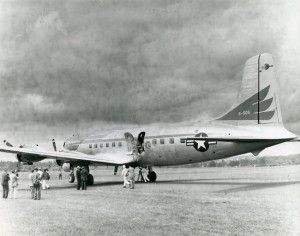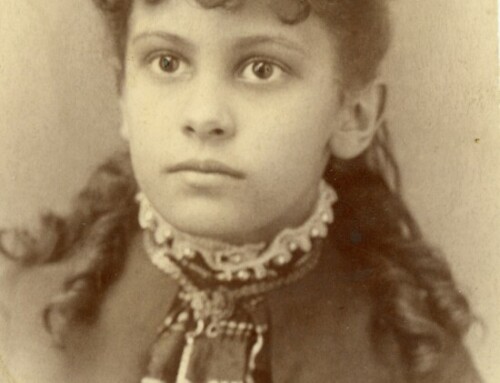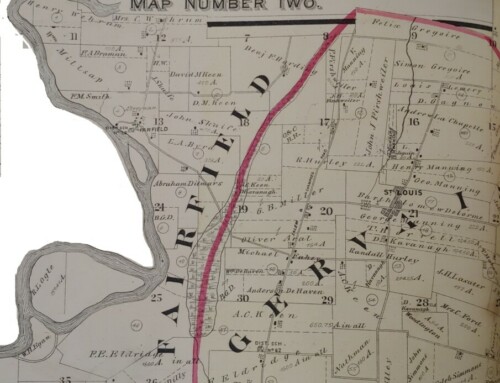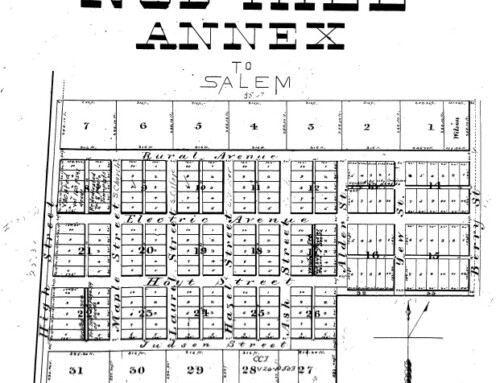
THE INDEPENDENCE, President Harry Truman’s plane at McNary Field in Salem Oregon, June 1948. Willamette Heritage Center, Al Jones Collection, 2007.001.2095.
By Kylie Pine
THE INDEPENDENCE comes to Salem
This photo from the Willamette Heritage Center colections (2007.001.2095) dates from the June 11, 1948 visit of President Harry Truman. He touched down at McNary Field aboard the DC-6 Independence. The plane, in keeping with its nickname, was commissioned on July 4, 1947 and was just the second aircraft built specifically to serve a United States President.[1] It replaced the hilariously nicknamed Sacred Cow VC-54C utilized by President Roosevelt[2] and could boast a maximum speed of 360 miles per hour, room for nine crew members and 25 passengers and a range of 4,400 miles. It was named in honor of President Truman’s hometown – Independence, Missouri.
President Truman Comes to View Columbia Flooding
Although President Truman was met with fanfare at the Salem airport, the reason for his visit was not something to celebrate. Successive waves of flooding along the Columbia River and its tributaries from Oregon to British Columbia had wreaked widespread devastation – destroying the city of Vanport, Oregon, forcing 60,000 people from their homes, causing millions of dollars of damage and killing thirty people. Flood waters covered over 650 square miles in the U.S. and Canada in what the media alliteratively called the “far flung flood front.”[3] The damage was so severe that the Japanese house of representatives adopted a resolution of sympathy for the victims of the Oregon flood.[4]
Salem Reception
President Truman arrived for his brief stop in Salem on a rainy Friday morning at exactly 11 a.m.[5] The Independence had left McChord Air Force Base near Tacoma and had dropped down under the cloud cover at Portland to allow the President an opportunity to view the flood damage.[6] The President’s plane couldn’t land in Portland because the airport was inundated.[7] All air traffic at McNary Field was grounded for thirty minutes before The Independence’s arrival. The reporting of the planes landing is exquisitely detailed. Oregon Statesman staff writer Marguerite Wright wrote: “Word comes that Mr. Truman’s plane will be a few minutes late. Then suddenly, a long line of brightly-polished cars, with their headlights on, swing into the runway, circles around and parks, in neat rows on a grass strip. Then there are a lot more policemen and state troopers and men that look as though they might be carrying shoulder holsters under their commonplace tweed coats. Across the field, behind the wire fence, are the people who didn’t have state police permission to get onto the airport, holding their children on their shoulders so the children can see, too. Then, there it is – the Independence. Harry S. Truman’s big plane, flying south, turning, landing, taxing to a stop by the cars where the secret service chief and the photographers form the first line of reception. The ladder comes down, some men get down a little awkwardly after sitting so long, and the people waiting on the ground press forward.”[8] A little more subdued, but still dripping with details her counterpart at the Capital Journal James Olson reported: “The crowd at the field was not large, and was augmented by passengers awaiting departure of grounded passenger planes. The president was wearing a dark striped gray suit, blue tie and a gray hat. After the Independence had landed, it was found that no ramp had been provided for the accommodation of members of the president’s party. An emergency automatic stairway was lowered after a few minutes delay and after several secret service men had alighted the president walked down the rather steep stairway.”[9]
The Independence made a longer stay in Salem than its riders. After a quick transfer into a motorcade, the President paraded through downtown Salem in the back of a 1949 green Cadillac convertible[10] on his way north 54 miles to Portland where the President would be allowed to see the damage on the ground and address the country in a nationwide broadcast.[11] As he passed the Capitol, a crowd of 200 people greeted him. Again, the reporting missed few details in their poetical recounting later that afternoon: “A stiff breeze kept him fiddling with the lapel to his grey double breasted suit while riding in the open car, but his deeply tanned and smiling face showed calm. While the turnout at the state capitol was far smaller than those accorded to Republican party candidates who visited Salem prior to the May 21 primary – even smaller than the one which heard Henry Wallace at Willamette university, the downtown throng far surpassed those which saw other presidential hopefuls.”
Politics As Usual?
Despite many claims in the headlines that the President was putting aside politics for the day to focus on flooding issues,[12] it seemed to ooze out in every report. The President’s remarks from the back of a train at the Salem Rail depot as he left for California later that afternoon focused on what read like thinly veiled talking points specifically for Oregon voters: his trying not to catch Potomac Fever (a.k.a. a Presidential ego) and his support of hydro-power and reclamation programming. [13] The politicking was probably unavoidable at the height of the 1948 Presidential election season – an election that President Truman would so unexpectedly win that the Chicago Daily Tribune famously printed the wrong headline: Dewey Defeats Truman. His efforts met with mixed results, at least for a six year old Delbert Loose. When asked what he thought he answered: “Sure, I like him. He’s the president.”[14]
This article was originally published in the Statesman Journal, Sunday July 2, 2017. It is reproduced here with citations for reference purposes.
Sources
[1] “Douglas VC-118 ‘The Independence’” National Museum of the US Airforce.
[2] “Douglas VC-54C ‘Sacred Cow.’” National Museum of the US Air force.
[3] “Flood situation Grows More Grave as Swollen Rivers in North Rise Under Blazing Sun.” Capital Journal. 9 June 1948, pg 1.
[4] “Word of Sympathy Sent by Japanese.” Capital Journal. 9 June 1948, pg 1. News of the resolution was sent from General Douglas MacArthur to interim Oregon Governor John H. Hall. It read in part that the house “sincerely sympathizes with the sufferings of the people of the state of Oregon, United States of America, arising from the recent disastrous flood and presents it smessage of heartfelt sympathy on behalf of the Japanese people.”
[5] Olson, James D. “President Truman Salem Guest Briefly Today; Politics Out As Chief Sees Flood Disaster.” Capital Journal. 11 June 1948, pg 1.
[6] “President Truman in Flight Over Portland Region Views New Damage from Columbia.” The Bend Bulletin. 11 June 1948, pge 1.
[7] “Truman Sees Flooded Areas from Air En route to Portland Speech.” Corvallis Gazette-Times. 11 June 1948, pg 1.
[8] Wright, Marguerite
[9] Olson, James D. “President Truman Salem Guest Briefly Today; Politics Out As Chief Sees Flood Disaster.” Capital Journal. 11 June 1948, pg 1.
[10] Thomas, Doug. “Truman Smiles Greeting Here.” Capital Journal. 11 June 1948, pg 1.
[11] Olson, James D. “President Truman Salem Guest Briefly Today; Politics Out As Chief Sees Flood Disaster.” Capital Journal. 11 June 1948, pg 1. See also text of comments here: The American Presidency Project – 126- Rear Platform and Other Informal Remarks in Oregon June 11, 1948.
[12] [12] Olson, James D. “President Truman Salem Guest Briefly Today; Politics Out As Chief Sees Flood Disaster.” Capital Journal. 11 June 1948, pg 1.
[13] “Ex-Gov. Pierce Tells Crowd at Depot President ‘Brave Man’; Truman Supports Flood Control.” Oregon Statesman. 12 Jun 1948, pg 5.
[14] Wright, Margaret. “Townspeople, Secret Service Welcome Truman at the Airport.” Oregon Statesman 12 June 1948, page 5.







Leave A Comment